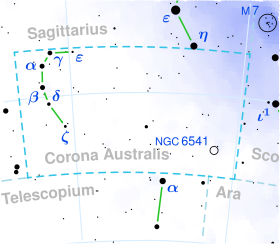Astronomy:HD 172991
| Observation data Epoch J2000.0 Equinox (celestial coordinates) | |
|---|---|
| Constellation | Corona Australis |
| Right ascension | 18h 44m 57.15228s[1] |
| Declination | −39° 41′ 10.2781″[1] |
| Apparent magnitude (V) | 5.44±0.01[2] |
| Characteristics | |
| A | |
| Spectral type | K1/2III[3] |
| B−V color index | +0.87[4] |
| B | |
| Spectral type | B9/A1V[3] |
| Astrometry | |
| Radial velocity (Rv) | −17.4±0.8[5] km/s |
| Proper motion (μ) | RA: +9.815[1] mas/yr Dec.: −6.261[1] mas/yr |
| Parallax (π) | 2.6806 ± 0.1453[1] mas |
| Distance | 1,220 ± 70 ly (370 ± 20 pc) |
| Absolute magnitude (MV) | −2.56[6] |
| Details | |
| A | |
| Mass | 4.98±0.05[7] M☉ |
| Radius | 53.9±3.0[8] R☉ |
| Luminosity | 1,750+188−154[1] L☉ |
| Surface gravity (log g) | 1.03[9] cgs |
| Temperature | 4,990±123[10] K |
| Metallicity [Fe/H] | −0.41[9] dex |
| Rotational velocity (v sin i) | 3.9±2[11] km/s |
| Other designations | |
| Database references | |
| SIMBAD | data |
HD 172991, also known as HR 7031 or rarely 20 G. Coronae Australis, is a binary star[13] located in the southern constellation Corona Australis. It has a combined apparent magnitude of 5.44,[2] making it faintly visible to the naked eye. The system is located relatively far at a distance of 1,220 light years based on Gaia DR3 parallax measurements[1] but is receding with a heliocentric radial velocity of −17.4 km/s.[5] At its current distance HD 172991's brightness is diminished by magnitudes due to interstellar dust and it has an absolute magnitude of −2.56.[6]
HD 172991 has a stellar classification of K1/2 III,[3] indicating that it is an evolved red giant. The companion, HD 172992, is a B-type star with a stellar classification of B9/A1 V.[3] Although the two components can be resolved in the spectrum, they cannot be observed in telescopes, making observation difficult.[14]
HD 172991 has 4.98 times the mass of the Sun[7] but it has expanded to 53.9 times the Sun's radius.[8] It radiates 1,750 times the luminosity of the Sun[1] from its enlarged photosphere at an effective temperature of 4,990 K,[10] giving it a yellowish-orange hue. It is metal deficient with an iron abundance 39% of the Sun's ([Fe/H] = −0.41)[9] and spins modestly with a projected rotational velocity of 3.9 km/s.[11]
References
- ↑ Jump up to: 1.0 1.1 1.2 1.3 1.4 1.5 1.6 Vallenari, A. et al. (2022). "Gaia Data Release 3. Summary of the content and survey properties". Astronomy & Astrophysics. doi:10.1051/0004-6361/202243940 Gaia DR3 record for this source at VizieR.
- ↑ Jump up to: 2.0 2.1 Høg, E.; Fabricius, C.; Makarov, V. V.; Urban, S.; Corbin, T.; Wycoff, G.; Bastian, U.; Schwekendiek, P. et al. (March 2000). "The Tycho-2 catalogue of the 2.5 million brightest stars". Astronomy and Astrophysics 355: L27–L30. ISSN 0004-6361. Bibcode: 2000A&A...355L..27H.
- ↑ Jump up to: 3.0 3.1 3.2 3.3 Houk, N. (1982). Michigan Catalogue of Two-dimensional Spectral Types for the HD stars. Volume_3. Declinations -40_ƒ0 to -26_ƒ0. Bibcode: 1982mcts.book.....H.
- ↑ Corben, P. M.; Stoy, R. H. (1968). "Photoelectric Magnitudes and Colours for Bright Southern Stars". Monthly Notes of the Astronomical Society of South Africa 27: 11. ISSN 0024-8266. Bibcode: 1968MNSSA..27...11C.
- ↑ Jump up to: 5.0 5.1 Gontcharov, G. A. (November 2006). "Pulkovo Compilation of Radial Velocities for 35,495 Hipparcos stars in a common system". Astronomy Letters 32 (11): 759–771. doi:10.1134/S1063773706110065. ISSN 1063-7737. Bibcode: 2006AstL...32..759G.
- ↑ Jump up to: 6.0 6.1 Anderson, E.; Francis, Ch. (May 2012). "XHIP: An extended hipparcos compilation". Astronomy Letters 38 (5): 331–346. doi:10.1134/S1063773712050015. ISSN 1063-7737. Bibcode: 2012AstL...38..331A.
- ↑ Jump up to: 7.0 7.1 Hohle, M.M.; Neuhäuser, R.; Schutz, B.F. (April 2010). "Masses and luminosities of O- and B-type stars and red supergiants". Astronomische Nachrichten 331 (4): 349–360. doi:10.1002/asna.200911355. ISSN 0004-6337. Bibcode: 2010AN....331..349H.
- ↑ Jump up to: 8.0 8.1 Kervella, P.; Thévenin, F.; Di Folco, E.; Ségransan, D. (October 2004). "The angular sizes of dwarf stars and subgiants. Surface brightness relations calibrated by interferometry". Astronomy & Astrophysics 426 (1): 297–307. doi:10.1051/0004-6361:20035930. ISSN 0004-6361. Bibcode: 2004A&A...426..297K.
- ↑ Jump up to: 9.0 9.1 9.2 Anders, F. et al. (August 2019). "Photo-astrometric distances, extinctions, and astrophysical parameters for Gaia DR2 stars brighter than G = 18". Astronomy & Astrophysics 628: A94. doi:10.1051/0004-6361/201935765. ISSN 0004-6361. Bibcode: 2019A&A...628A..94A.
- ↑ Jump up to: 10.0 10.1 Stassun, Keivan G. et al. (9 September 2019). "The Revised TESS Input Catalog and Candidate Target List". The Astronomical Journal 158 (4): 138. doi:10.3847/1538-3881/ab3467. Bibcode: 2019AJ....158..138S.
- ↑ Jump up to: 11.0 11.1 De Medeiros, J. R.; Alves, S.; Udry, S.; Andersen, J.; Nordström, B.; Mayor, M. (January 2014). "A catalog of rotational and radial velocities for evolved stars V: Southern stars *". Astronomy & Astrophysics 561: A126. doi:10.1051/0004-6361/201220762. ISSN 0004-6361. Bibcode: 2014A&A...561A.126D.
- ↑ "HD 172991". SIMBAD. Centre de données astronomiques de Strasbourg. http://simbad.u-strasbg.fr/simbad/sim-basic?Ident=HD+172991.
- ↑ Eggleton, P. P.; Tokovinin, A. A. (11 September 2008). "A catalogue of multiplicity among bright stellar systems". Monthly Notices of the Royal Astronomical Society 389 (2): 869–879. doi:10.1111/j.1365-2966.2008.13596.x. ISSN 0035-8711. Bibcode: 2008MNRAS.389..869E.
- ↑ Bonneau, D.; Blazit, A.; Foy, R.; Labeyrie, A. (November 1980). "Speckle interferometric measurements of binary stars.". Astronomy and Astrophysics Supplement Series 42: 185–188. ISSN 0365-0138. Bibcode: 1980A&AS...42..185B.
<ref> tag with name "Gould1879" defined in <references> is not used in prior text.
 |


